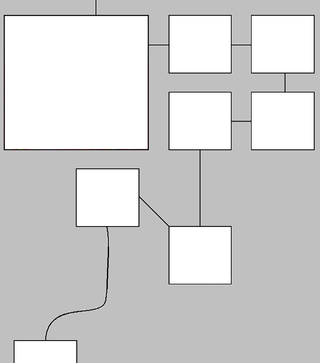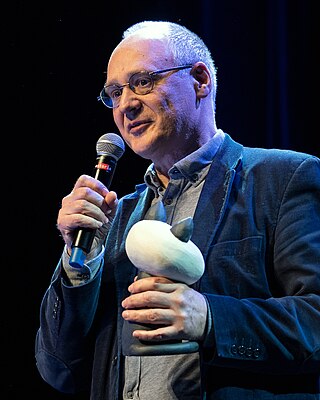Bandes dessinées, abbreviated BDs and also referred to as Franco-Belgian comics, are comics that are usually originally in French and created for readership in France and Belgium. These countries have a long tradition in comics, separate from that of English-language comics. Belgium is a mostly bilingual country, and comics originally in Dutch are culturally a part of the world of bandes dessinées, even if the translation from French to Dutch far outweighs the other direction.
Webcomics are comics published on the internet, such as on a website or a mobile app. While many webcomics are published exclusively online, others are also published in magazines, newspapers, or comic books.

Quebec comics are French language comics produced primarily in the Canadian province of Quebec, and read both within and outside Canada, particularly in French-speaking Europe.

The infinite canvas is the feeling of available space for a webcomic on the World Wide Web relative to paper. The term was introduced by Scott McCloud in his 2000 book Reinventing Comics, which supposes a web page can grow as large as needed. This infinite canvas gives infinite storytelling features and creators more freedom in how they present their artwork.
Les Humanoïdes Associés is a French-American publishing house specializing in comics and graphic novels, founded in December 1974 by comic artists Mœbius, Jean-Pierre Dionnet, Philippe Druillet, and financial director Bernard Farkas.
Éric Thériault is a Canadian comics artist, writer, illustrator and blogger living in Montreal, Quebec, Canada.

Opération Teddy Bear is an educational comic strip video game released in 1996. It was developed by Index+ and a co-production with Flammarion, and is written by Edouard Lussan.
Le Journal de Mickey is a weekly French comics magazine established in 1934, featuring Disney comics from France and around the world. The magazine is currently published by Unique Heritage Media. It is centered on the adventures of Mickey Mouse and other Disney characters but also contains other comics. Le Journal de Mickey is credited with "the birth of the modern bande dessinée". It is now the most popular French weekly magazine for children between 8 and 13 years old.

Thierry Groensteen is one of the leading French-speaking comics researchers and theorists, whose work has found influence beyond that field.
Comics has developed specialized terminology. Several attempts have been made to formalize and define the terminology of comics by authors such as Will Eisner, Scott McCloud, R. C. Harvey and Dylan Horrocks. Much of the terminology in English is under dispute, so this page will list and describe the most common terms used in comics.

Bastien Vivès is a French comic book artist.

Pénélope Bagieu is a French illustrator and comic designer. She is best known for her blog BDs My Quite Fascinating Life and Les Culottées.Les Culottées was compiled and released in English as the graphic novel Brazen: Rebel Ladies Who Rocked the World, which received widespread recognition. She has also created blog BDs California Dreamin' and Joséphine.

Cyril Pedrosa is a French comic book artist, colorist, and writer.
Notable events of the late 1990s in webcomics.

Delitoon is a French webtoon service established by Didier Borg in 2011. Initially solely a Casterman product, Delitoon has since been partly acquired by Daou Technology Inc. and has partnered with Sina Weibo. Delitoon offers a large variety of both Korean and French webtoons and makes use of a micropayment system.

Yves Bigerel, also known as "Balak", is a French comics artist and animator. He is mostly known in France for the comic book series Lastman. In 2009, Balak invented a new digital comics narrative technique which he called "turbomedia"; his work was noticed by Marvel editor Joe Quesada, who recruited him to help establish the Marvel digital imprint "Infinite Comics". He served as creative director and voice of the character Bullfrog on the 2023 adult animated series Captain Laserhawk: A Blood Dragon Remix.
Mira Falardeau is a French Canadian historian, professor, and author of comic strips. Falardeau has devoted works to Québec animated films, Québec comic strips and caricatures in Québec, focusing on visual humour in all its forms. She taught as a professor of cinema and communication at Laval University and the University of Ottawa. Falardeau has also curated exhibitions in the visual arts and operated a small publishing house.

Blutch, pen name of Christian Hincker is a French comic book author. He is considered one of the main authors of French comics since the early 1990s.

Fabien Toulmé is a French comic book author.

Lisa Mandel is a French bande dessinée comic book author. With Jul Maroh, Mandel co-founded the Collective of female comics creators against sexism (2015). In 2021, Mandel launched the Exemplaire publishing house, with the subtitle, La maison qui édite autrement.
![Martin Vidberg [fr] posted this political cartoon on his blog in 2008. Martin Vidberg - Magic Darcos.gif](http://upload.wikimedia.org/wikipedia/commons/thumb/a/a8/Martin_Vidberg_-_Magic_Darcos.gif/220px-Martin_Vidberg_-_Magic_Darcos.gif)












